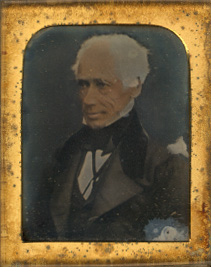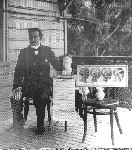
The History of Phrenology
Origins
Phrenology is the science which studies the relationships between a person's
character and the morphology of the skull. It is a very ancient object
of study. The first philosopher to locate mental faculties in the head
was in fact Aristoteles.
Several typologies have been defined, linking physionomy with character. The study of the face, physiognomony, has been particularly studied by the 18th century Swiss author Lavater.
Gall and the birth of modern Phrenology
 The real scientific
Phrenology, which established a direct link between the morphology of the
skull and the human character, was discovered by the Austrian physician
Franz Joseph GALL (1758-1828). Gall put the foundations for an anatomic
caracteriology. He was one of the first to consider the brain as the home
of all mental activities.
The real scientific
Phrenology, which established a direct link between the morphology of the
skull and the human character, was discovered by the Austrian physician
Franz Joseph GALL (1758-1828). Gall put the foundations for an anatomic
caracteriology. He was one of the first to consider the brain as the home
of all mental activities.
In the introduction to his main work The Anatomy and Physiology of
the Nervous System in General, and of the Brain in Particular, Gall
makes the following statement in regard to the principles on which he based
his doctrine:
- That moral and intellectual faculties are innate
- That their exercise or manifestation depends on organisation
- That the brain is the organ of all the propensities, sentiments and faculties
- That the brain is composed of many particular organs as there are propensities, sentiments and faculties which differ essentially from each other.
- That the form of the head or cranium represents the form of the brain, and thus reflects the relative development of the brain organs.
Through careful observation and extensive experimental measurements, Gall was able to link aspects of character, called faculties, to precise brain localisations.
The most important collaborator of Gall was Johann SPURZHEIM (1776-1832), who successfully disseminated Phrenology in the UK and the USA.
 Other
important authors on the subject in the last century include the Scottish
brothers George COMBE (1788-1858) and Andrew COMBE (1797-1847).
George Combe was the author of some of the most popular works on Phrenology
and the hygiene of the mind, like The Consitution of Man or Elements
of Phrenology. The picture right shows a daguerrotype of
George Combe. (Thanks to Miguel Angel Cuarterolo from Argentina for this
image).
Other
important authors on the subject in the last century include the Scottish
brothers George COMBE (1788-1858) and Andrew COMBE (1797-1847).
George Combe was the author of some of the most popular works on Phrenology
and the hygiene of the mind, like The Consitution of Man or Elements
of Phrenology. The picture right shows a daguerrotype of
George Combe. (Thanks to Miguel Angel Cuarterolo from Argentina for this
image).
The American brothers Lorenzo Niles FOWLER (1811-1896) and Orson S. FOWLER (1809-1887) were the leading Phrenologists of their time. Lorenzo spend much of his life in England where he set up the famous Phrenological publishing house of L.N Fowler & Co.
Victorian Phrenology
 In the early 19th century,
Phrenology gained a rapidly growing interest. Some scrupless people did
however abuse the science for commercial purposes, and the Victorian period
saw the emergence of Phrenological parlours which were closer to astrology,
chiromancy, and the like, than to real scientific characterology. Unfortunately,
those con-men have done a lot to stain the image of Phrenology as a real
science, and their bad influence lives up to today.
In the early 19th century,
Phrenology gained a rapidly growing interest. Some scrupless people did
however abuse the science for commercial purposes, and the Victorian period
saw the emergence of Phrenological parlours which were closer to astrology,
chiromancy, and the like, than to real scientific characterology. Unfortunately,
those con-men have done a lot to stain the image of Phrenology as a real
science, and their bad influence lives up to today.
Disclaimer:
No one but the author of these pages
accounts
for their contents.